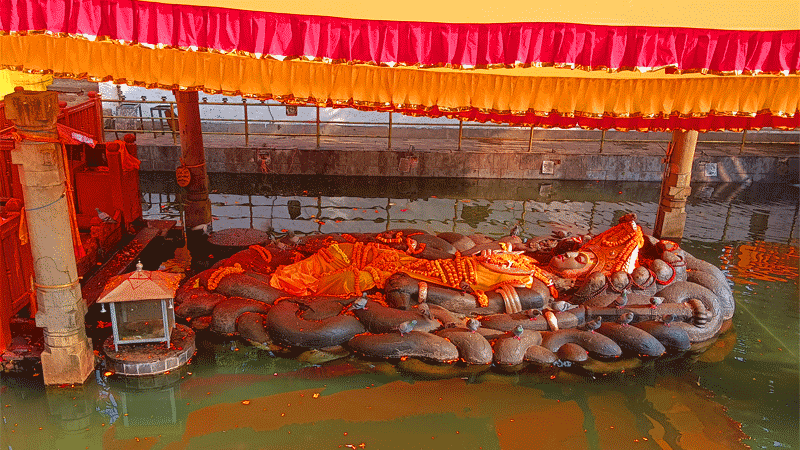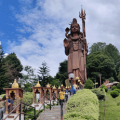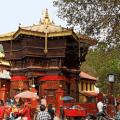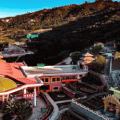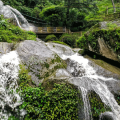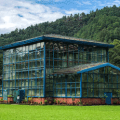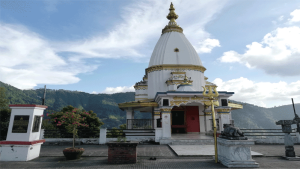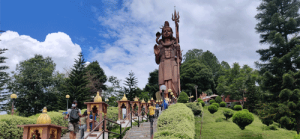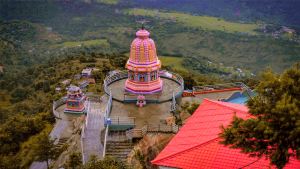Budhanilkantha Temple, located in Budhanilkantha, Nepal is a Hindu Temple. It is in the north of Kathmandu Valley, more likely on the foot of Shivapuri. This holy place and Lord Mahavishnu are called Budhanilkantha. This is because the poison left a blue bruise on the throat of Lord Mahavishnu. The Budhanilkantha Temple is an open-air temple dedicated to the Lord Mahavishnu. We can see a floating statue of Lord Vishnu in the water of holy Gosaikunda. The sleeping Lord Vishnu is surrounded by water on all sides. People believe that the water is from the holy lake of Nepal, Gosaikunda. Also, people call this temple as Narayanthan Temple. We can see a large reclining statue of Lord Mahavishnu in the temple under the holy cloth.
History tells us that the statue of Budhanilkantha was made during the Lichhavi period. The sculpture is 5m long and made from a single block of basalt stone. People also believe that a mirror image of Lord Shiva lies underside of the sculpture. Although people of all religions visit this holy place, only Hindus and Buddhists enter the temple. However, it is a Hindu temple, and Buddhists both enter the temple. This is because people believe that Lord Buddha is the incarnation of Lord Vishnu. And, Buddhists believe Lord Vishnu is a protector of Lord Buddha. But this is only the belief Budhanilkantha has nothing to do with Lord Buddha and Buddhism. Besides, people believe that Lord Vishnu has thousands of names and Budhanilkantha is one of them.
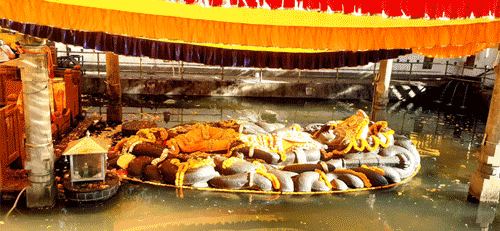
The Origin of Budhanilkantha
The statue of Lord Vishnu at Budhanilkantha is under the open sky. This is the largest single-stone statue of ancient Nepal. History explains that the statue evolved during the Lichhavi Period. Although histories and different books wrote different beliefs and theories about the origin of Budhanilkantha. But no one exactly knows how one of the greatest single-stone sculptures originated.
Some believe that in ancient times, a king of Nepal visited the shrines of Badrinath and Kedarnath in India many times. Harihar felt pleased with the often visit of the King and said, “You don’t have to go anywhere else to visit me, I will be born in Nepal”. After that, Budhanilkantha originated in Nepal.
Another theory says that a farmer was digging his field, and he hit the toe of the idol while digging. The idol was injured, and blood came from the toe of the statue. Later, people were curious about the place and started digging. While excavating the site, the local people found a huge statue under. The people then dug up the idol and kept the statue in the same pond. Because the name of the farmer who hit the toe of the idol was Nilakantha, the statue’s name was Budhanilkantha.
As per another belief, King Pratap Malla wanted to place the idol of Budhanilkantha in the courtyard of Hanuman Dhoka from there and install it. King Pratap Malla once saw a dream where he was told not to move the idol and that he and his successors should not even visit this idol. If they do, it will be unlucky. Later that, Pratap Malla erected a statue of Budhanilkantha at Balaju, which visitors can find still there. Also, from this time onwards, the Shah and Malla kings of Nepal did not see and worship Budhanilkantha.
The Religious Significance of Budhanilkantha
Pilgrims who have faith in Lord Vishu visit Budanilkantha. There is a belief that the statue is more than 1400 years old. According to Hindu scriptures, Lord Vishnu goes into yogic sleep for a period of four months from the day of Devshayani Ekadashi. People believe that the god Vishnu rests on the coiled body of his serpent, Sheshnaag. And, the place where Lord Vishnu sleep is in the Kshirasagara or the cosmic ocean.
On the day of Prabodhini Ekadashi after four months from Devshayani Ekadashi Lord Vishnu wakes up. Hindus believe that Lord Shiva takes care of the Universe while Lord Vishnu rests for four months. Therefore, Chaturmas starts with an ode to Lord Shiva in these four months. The sacred Chaturmas period of Shravan, Bhadrapad, Ashwin, and Kartik months will begin with this Ekadashi. Hindus celebrate some of the big festivals during these four months. Moreover, this includes Krishna Janmashthami, Ganesh Chaturthi, Shravan Somwar Vrat, Navratri, and Diwali while Lord Vishnu is sleeping. Occasions such as marriages, engagements, naming ceremonies, and housewarming functions do not take place during this period.
Festivals at Temple
There is a large festival around the Budhanilkantha temple during Haribondhini Ekadashi. And people call this festival Haribondhini Ekadashi Mela. This festival takes place on the 11th day of the Nepali month Kartik (October-November) every year. During this festival, thousands of pilgrims from inside and outside the country visit here. Mostly, Hindus who have great faith in Lord Mahavishnu visit this place. People believe during this period that is Haribondhini Ekadashi, Lord Mahavishnu woke up from long four months of sleep. Moreover, pilgrims mostly visit this temple during Ekadashis.
More About the Temple Area
Besides the sleeping statue of Lord Vishnu, there are other temples around to worship. We can find temples of Shree Ganesh, Laxmi Mata, Radha Krishna, Saraswati Mata, and many more. Visitors around the temple enjoy feeding grains to a large number of pigeons. Occasions like marriages and bratabandha take place in the area. There is a Gurukul near the temple. Likewise, visitors can enjoy local foods in the Budhanilkantha area. There are a number of local hotels and restaurants. Also, pilgrims can enjoy Sel Roti, Puri Tarkari, and many other local foods after worshipping Lord Vishnu.

10 Interesting Facts About Budhanilkantha
- Budhanilkantha gives the impression dedicated to Lord Buddha. However, in Nepal, the Budhanilkantha temple refers to Lord Vishnu.
- Budhanilkantha’s reclining Lord Vishnu statue is floating on water. Though this is still only in belief scientifically because of religious reasons. However, there is a belief that the statue may be very rich in silica.
- The Budhanilkantha means “Old Blue Throat” or the “Blue Throat”, which refers to Lord Shiva. But the statue is of Lord Vishnu.
- Lord Vishnu in the Buddha Neelakanta Temple resembles those features of the Buddha.
- Lord Vishnu’s sleeping statue in Budhanilkantha, is the largest stone-carved sculpture in Nepal to date.
- Budhanilkantha Temple is a sacred place that both Hindu and Buddhist pilgrims visit.
- The statue is 5 meters long and we can see a supine or reclining position in the center of a pool measuring about 13 meters long.
- People believe that the reclining statue of Vishnu in the Budhanilkantha temple has a mirror image below the surface of the water too.
- King Pratap Malla once saw a dream where he was told not to move the idol and that he and his successors should not even visit this idol. From this time onwards, the Shah and Malla kings of Nepal did not see and worship Budhanilkantha.
- The statue is made from a single block of black basalt rock. The statue has four hands that hold the Shankha, Chakra, Gadha, and a gem.
How to reach Budhanilkantha?
Budhanilkantha Temple is about 9km away from the center of Kathmandu, Ratnapark. You can get a public vehicle, Micro from RNAC Kathmandu up to the destination. Moreover, you can get a public vehicle from different places in Kathmandu like Koteshwor, Jorpati, Naya Bus Park, etc. Also, you can book a cab and visit the place.
There is a Buddhist Gumba just above the Budhanilkantha Temple which people call Jamchen Vijaya Stupa. It takes about a 10-15 minute drive from Budhanilkantha to reach Jamchen Vijay Stupa. You can also visit Shivapuri after worshipping at Budhanilkantha.
Google Map of Budhanilkantha Temple
Budhanilkantha is famous because the floating statue of Lord Mahavishnu makes the temple mysterious.
The statue of Budhanilkantha is related to Lord Mahavishnu.
Budhanilkantha Temple is known as the mysterious temple in Nepal.
To sum up, Budhanilkantha Temple is a religious and cultural site in the northwestern part of Kathmandu, the capital city of Nepal. Similarly, the historic place is famous for Budhanilkantha Temple. The temple lies at the base of the Shivapuri Hills. Likewise, it is one of the most worshipped and visited pilgrimage sites for Hindus in Nepal.

